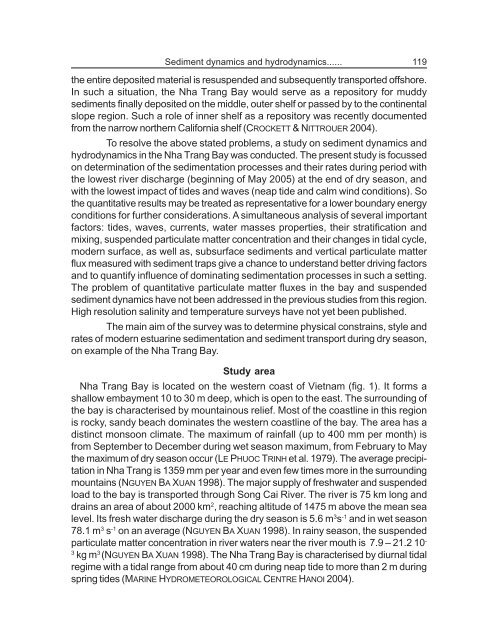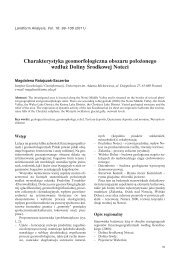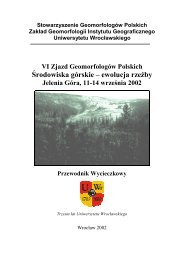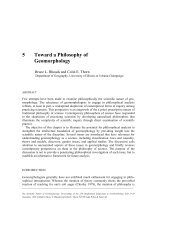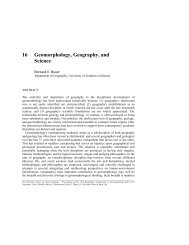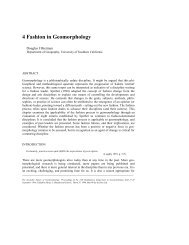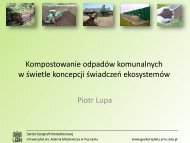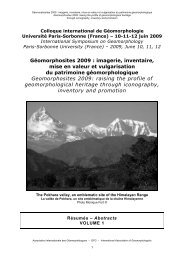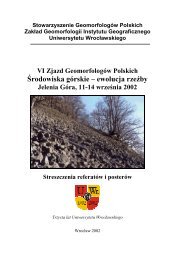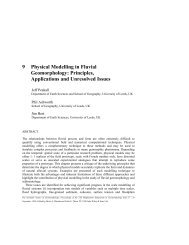Meyniana
Meyniana
Meyniana
You also want an ePaper? Increase the reach of your titles
YUMPU automatically turns print PDFs into web optimized ePapers that Google loves.
Sediment dynamics and hydrodynamics...... 119<br />
the entire deposited material is resuspended and subsequently transported offshore.<br />
In such a situation, the Nha Trang Bay would serve as a repository for muddy<br />
sediments finally deposited on the middle, outer shelf or passed by to the continental<br />
slope region. Such a role of inner shelf as a repository was recently documented<br />
from the narrow northern California shelf (CROCKETT & NITTROUER 2004).<br />
To resolve the above stated problems, a study on sediment dynamics and<br />
hydrodynamics in the Nha Trang Bay was conducted. The present study is focussed<br />
on determination of the sedimentation processes and their rates during period with<br />
the lowest river discharge (beginning of May 2005) at the end of dry season, and<br />
with the lowest impact of tides and waves (neap tide and calm wind conditions). So<br />
the quantitative results may be treated as representative for a lower boundary energy<br />
conditions for further considerations. A simultaneous analysis of several important<br />
factors: tides, waves, currents, water masses properties, their stratification and<br />
mixing, suspended particulate matter concentration and their changes in tidal cycle,<br />
modern surface, as well as, subsurface sediments and vertical particulate matter<br />
flux measured with sediment traps give a chance to understand better driving factors<br />
and to quantify influence of dominating sedimentation processes in such a setting.<br />
The problem of quantitative particulate matter fluxes in the bay and suspended<br />
sediment dynamics have not been addressed in the previous studies from this region.<br />
High resolution salinity and temperature surveys have not yet been published.<br />
The main aim of the survey was to determine physical constrains, style and<br />
rates of modern estuarine sedimentation and sediment transport during dry season,<br />
on example of the Nha Trang Bay.<br />
Study area<br />
Nha Trang Bay is located on the western coast of Vietnam (fig. 1). It forms a<br />
shallow embayment 10 to 30 m deep, which is open to the east. The surrounding of<br />
the bay is characterised by mountainous relief. Most of the coastline in this region<br />
is rocky, sandy beach dominates the western coastline of the bay. The area has a<br />
distinct monsoon climate. The maximum of rainfall (up to 400 mm per month) is<br />
from September to December during wet season maximum, from February to May<br />
the maximum of dry season occur (LE PHUOC TRINH et al. 1979). The average precipitation<br />
in Nha Trang is 1359 mm per year and even few times more in the surrounding<br />
mountains (NGUYEN BA XUAN 1998). The major supply of freshwater and suspended<br />
load to the bay is transported through Song Cai River. The river is 75 km long and<br />
drains an area of about 2000 km 2 , reaching altitude of 1475 m above the mean sea<br />
level. Its fresh water discharge during the dry season is 5.6 m 3 s -1 and in wet season<br />
78.1 m 3 s -1 on an average (NGUYEN BA XUAN 1998). In rainy season, the suspended<br />
particulate matter concentration in river waters near the river mouth is 7.9 – 21.2 10 -<br />
3<br />
kg m 3 (NGUYEN BA XUAN 1998). The Nha Trang Bay is characterised by diurnal tidal<br />
regime with a tidal range from about 40 cm during neap tide to more than 2 m during<br />
spring tides (MARINE HYDROMETEOROLOGICAL CENTRE HANOI 2004).


